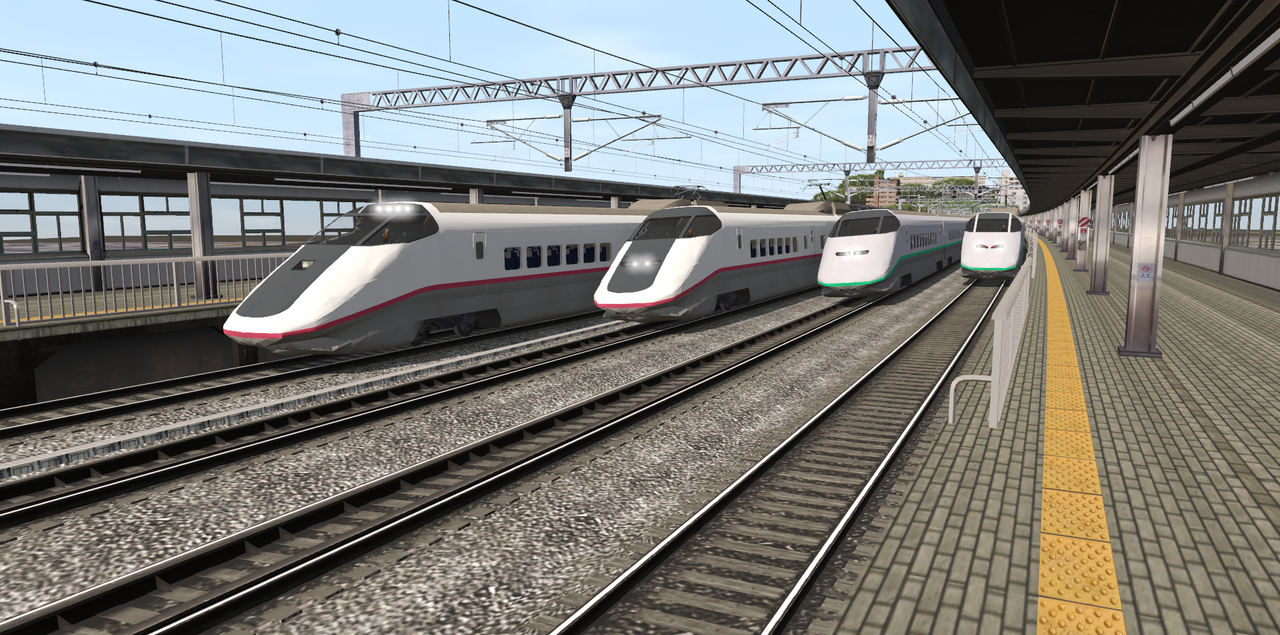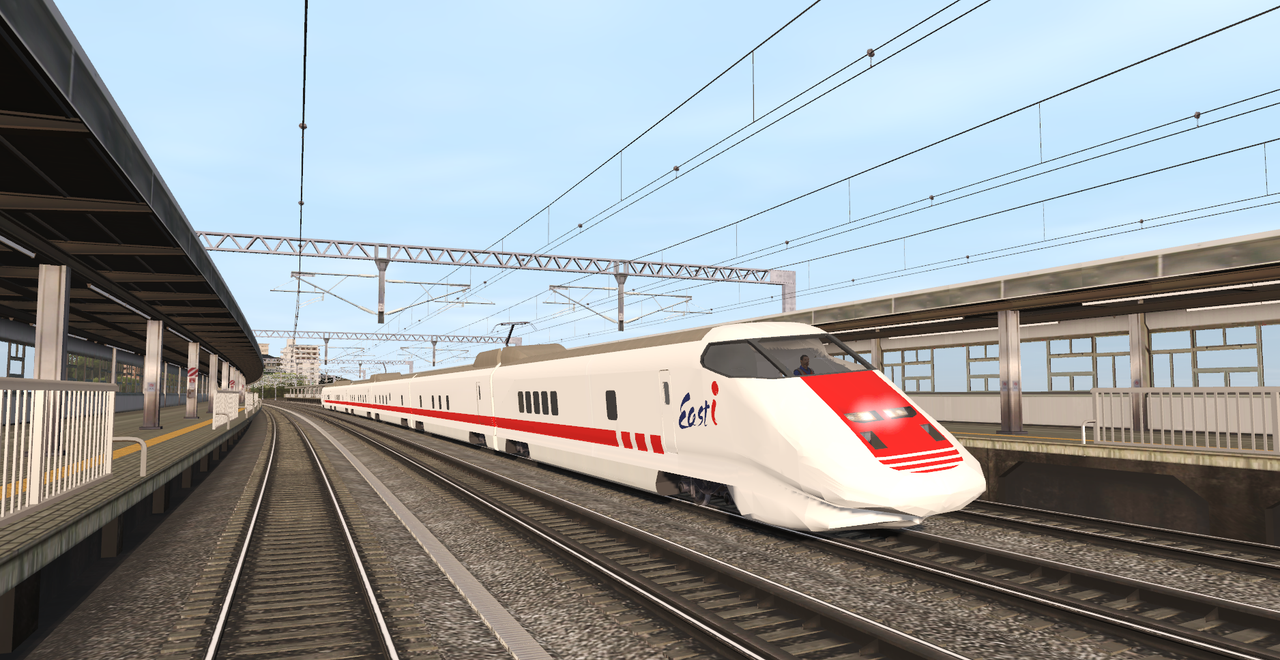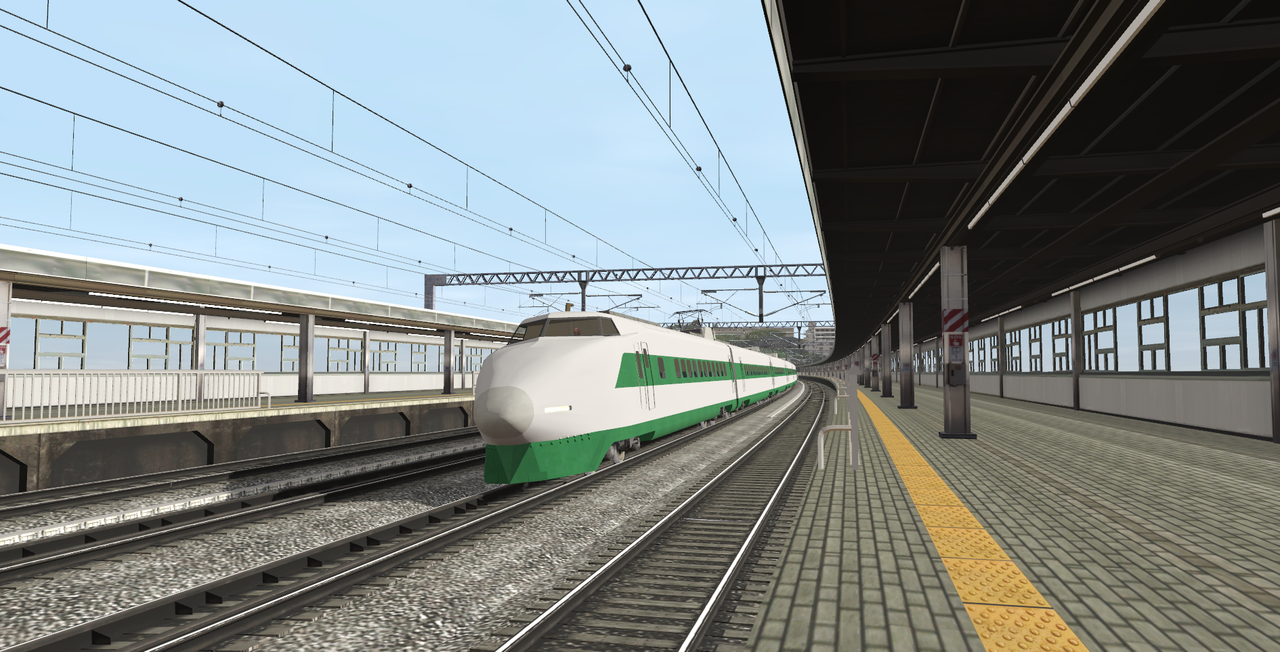Merry Christmas from Italy evryone!
As mentioned yesterday, i have a present for you all! - It's something many wanted for a long time and i'm sure it'll make even more people happy: the long-awaited E3 Series Shinkansen!!
From left to right: Akita Shinkansen Pre-Series Set S8/R1, Akita Shinkansen Full-Production E3 Series, Yamagata Shinkansen E3-1000 Series and the E3-2000 Series, also for the Yamagata Shinkansen.
It's already avaible on my website! - Complete with realistical "coupled" consists with Hirochi's E2, E4 and E5 Series.
The E3 Series Shinkansen began commercial services in 1997 with the opening of the 130Km-long Akita Shinkansen, Japan's second "Mini-Shinkansen" line (a "conventional" 1067mm-gauge line converted to standard gauge so to enable trough-services to and from "standard" Shinkansen lines, allowing for considerable reduction in travel times while avoiding the need to build an entirely dedicated Shinkansen line where population and ridership wouldn't justify such an expense) running for roughly 130Km between Morioka (where it branched off the Tohoku Shinkansen) and Akita via the re-gauged Ou Main Line.
For the new Mini-Shinkansen line, JR East opted for an entirely new design instead of continuing to manufacture the very recent 400 Series, wich had been introduced only a few years earlier in 1992. Nevertheless, the new trains, to be classified as the "E3 Series" (using JR East's brand new "Ex" designation for new-generation Shinkansen trains) were to be effectively based on the 400 Series, sharing the same dimensions (20m-long cars as opposed to standard Shinkansens' 25-27 meters and a 2950mm width, to fit the conventional lines' loading gauge as opposed to the 3380mm width of standard Shinkansen trains, with the eventual gap between the E3 Series and the platforms of standard Shinkansen stations, having been built for much larger trains, being bridged by retractible steps).
However, the new E3 Series fetaured several improvements compared to it's predecessor: it's bodyshell was made out of alluminium, making each car 2 tons lighter, internal seating was rearranged in a 2+2 formation (instead of a 2+1 formation on the 400 Series); the traction control was also changed, with the 400 Series' Thyristor Phase Control being changed for a more modern GTO-VVVF inverter. Finally, the top speed was raised as well, with the new E3 Series being rated for a maximium of 270Km/h (compared to 240Km/h for the 400 Series).
Being intended for Mini-Shinkansen services, the E3 Series were designed as multivoltage trains (25Kv 50Hz AC for the standard Shinkansen lines and 20Kv 50Hz AC for the converted "conventional" lines) and were fitted with both ATC-2 (and later D-ATC) saftey systems for Shinkansen lines as well as ATS-P for conventional lines.
The styling of the new trains, fetauring a sleek white livery with a magenta stripe and a dark grey front portion, was designed by the GK Industrial Design firm and overseen by Kenji Ekuan, a famous designer wich had previously designed several trains for JR East, including the Narita Express 253 Series, the 255 Series and the 209 Series (and among other things, the "Gingko Leaf" logo of the Tokyo Metropolitan Government and the world-famous Kikkoman Soy Sauce bottle as well).
Finally, the new E3 Series trains were intended to be formed in 5-car sets, with cars numbered 11 to 15 (in continuity with the 10-car Shinkansen sets they were intended to couple to), with car No.11 being the "Tokyo side" one (and the one that coupled to other trains) while car No.15 was the "Akita side" one. The fleet was to be manufactured jointly by Kawasaki Heavy Industries and Tokyu Car Co.
A "pre-series" set was completed early on in 1995 and handed over to JR East for initial testing. Classified as formation "S8" and formed as a 5-car set, this pre-series set was different in appearance compared to the under-construction "full production" trains, as it had a front styling reminescent of the early 400 Series, with the distinctive four-lamp top mounted headlights. With testing of the pre-series set being deemded successful, the full-production E3 Series fleet began commercial services on schedule on the 11th of May 1997, running seamlessly between Tokyo and Akita on brand-new
Komachi services, coupled between Tokyo and Morioka to
Yamabiko services operated either by the equally brand-new E2 Series or by a select number of relatively older 200 Series sets wich had been adapted for a quick-coupling system compatible with the E3 Series' one.
With the entry into service of the full production trains, the pre-series set was taken out of service and put in storage, however, as the new Komachi services were proving incredibly popular, JR East quickly decided to take the pre-production set and modify it to full-production standards (including the addition of a sixth car to match the lenght of the other E3s) to be used as an additional train. Reclassified as "Set R1", the pre-production set re-entered service in 1998; in the same year, all the other 15 E3 Series sets (R2 to R16) were lenghtened to six cars (now numbered 11 to 16) and a seventeenth 6-car set (R17) joined the fleet as well.
By 1998 a total of 17 E3 Series sets had been manufactured, but thanks to the ever increasing popularity of
Komachi services an additional nine E3 Series sets (R18 to R26) were oredered as well, being manufactured between 2002 and 2005, bringing the total to 26 E3 Series sets for the Akita Shinkansen. These were externally nearly identical to the late-1990s built E3 Series, but fetaured a few notable improvements, mainly the adoption of an up-to-date IGBT-VVVF inverter instead of a GTO-type one.
At around the same time, with the extension of the Yamagata Shinkansen, the other Mini-Shinkansen line, from Yamagata to Shinjo in 1999, a small fleet of new trains was needed. Since resuming production of the 400 Series was uneconomical, JR East decided to order two dedicated E3 Series sets for the Yamagata Shinkansen.
Classified as the "-1000 subseries", the Yamagata Shinkansen E3 Series sets were very similar to their Akita Shinkansen counterparts, as they fetaured the same bodyshell design and equipment, however there were two notable differences, with the livery, wich was changed to a silver and green one (designed to be similar to the one of the 400 Series) and with the formation, as Yamagata Shinkansen trains were formed as 7-car sets instead of the 6-car sets of the Akita Shinkansen.
Like the standard E3 Series for the Akita Shinkansen, the two E3-1000 Series trains were manufactured jointly by Kawasaki Heavy Industries and Tokyu Car Co. and were delivered in late 1999, classified as sets "L51" (built by Tokyu Car Co.) and "L52" (built by Kawasaki Heavy Industries). An additional E3-1000 Series set, manufactured by Tokyu Car Co. and classified as set "L53" entered service in 2005.
[continues in next post]

.


.
.

